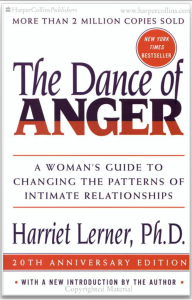
The reading list from my Creative Grief Coach certification course, included, “The Dance of Anger,” by Harriet Lerner, Ph.D. This book provides an honest assessment of how women express, repress, and manage their anger. Within the course, it aided us in our work as emotionally intelligent individuals and it helped us gain the skill that we need to bring to our coaching practice. For that practice, it is a helpful guide, because those who are grieving are dealing with a wide array of emotions, including, at times, anger. Also, we grieve in a community. This communal aspect of grief means that there will be multiple relationships touched by our grief journey and some of them may have patterns of anger.
Dr. Lerner presents many helpful techniques to work with anger. However, I’d like to focus on just two of them in this review. The first one is observation. This is an incredibly helpful technique in working with emotions in general. If we can pause and observe our emotional reaction, notice that it is occurring, where it is occurring in our body, and, then, with discernment, choose what we say and do in that moment, then this helps us with our emotional health and our relationships in general. I believe in the power of this for several reasons, including that it puts us first for a moment. I’m saying this as a woman who has bit her tongue and held her words back more than is probably prudent. I am not alone in this — many women do this and Dr. Lerner’s book is speaking to us — those who hold back and those who don’t. (Definitely, there are men who have this same emotional pattern, but this book focuses on women’s experiences.) Whatever, your pattern — hold back or not — observation is a helpful first step.
Another technique or directive from this book, that I find very helpful (and it is often a trigger for anger) is our desire to change another person. This pattern of trying to fix others comes from a place of over functioning. The healthier approach, if one desires change, is to change oneself. If you’re like me, that takes your breath away. “What? Me? Change?!” Dr. Lerner presents many examples in her book of women who stopped trying to change another person in their life and changed themselves instead. This takes introspection and courage. As with the first technique it requires that we notice that we’re in a pattern of trying to change another person, then making a conscious effort not to try to do that any more, and then, finally, changing ourselves in a meaningful and healthy way. Ironically, of course, because we are in a relationship, the other person often changes as well. Maybe not in the exact way that we would have prescribed, but as a reaction to the way we’ve changed.
If you’re looking to refine your steps in the dance of anger, I highly recommend Dr. Lerner’s book.


